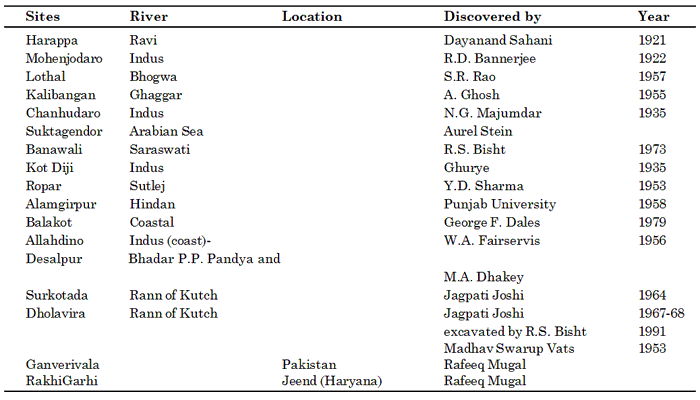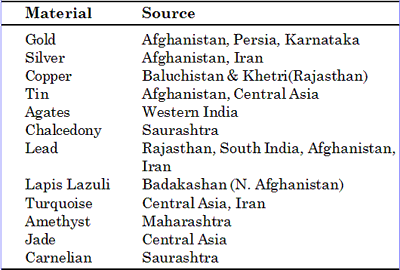(Sample Material) Online Coaching for CAPF (AC): History of India - "Ancient Indian History"
Online Coaching for UPSC Central Armed Police Forces (AC) Written Examination
History of India
Ancient Indian History
PRE-HISTORIC INDIA AND THE HARAPPAN CULTURE
The history of human settlements in India goes back to prehistoric times. No written records are available for the prehistoric period. However, plenty of archaeological remains are found in different parts of India to reconstruct the history of this period. They include the stone tools, pottery, artifacts and metal implements used by pre-historic people. The development of archaeology helps much to understand the life and culture of the people who lived in this period. In India, the prehistoric period is divided into the Paleolithic (Old Stone Age), Mesolithic (Middle Stone Age), Neolithic (New Stone Age) and the Metal Age. However, these periods were not uniform throughout the Indian subcontinent. The dating of the prehistoric period is done scientifically. The technique of radio-carbon dating is commonly used for this purpose. It is based on measuring the loss of carbon in organic materials over a period of time. Another dating method is known as dendro-chronology. It refers to the number of tree rings in wood. By counting the number of tree rings in the wood, the date of the wood is arrived at.
Paleolithic or Old Stone Age
The Old Stone Age sites are widely found in various parts of the Indian subcontinent. Some of the famous sites of Old Stone Age in India are:
- The Soan valley and Potwar Plateau on the northwest India.
- The Siwalik hills on the north India.
- Bhimpetka in Madhya Pradesh.
- Adamgarh hill in Narmada valley.
- Kurnool in Andhra Pradesh and
- Attirampakkam near Chennai.
Their way of life became modified with the passage of time since they made attempts to domesticate animals, make crude pots and grow some plants. A few Old Stone Age paintings have also been found on rocks at Bhimbetka and other places.
Mesolithic or Middle Stone Age
The next stage of human life is called Mesolithic or Middle Stone Age which falls roughly from 10000 B.C. to 6000 B.C. It was the transitional phase between the Paleolithic Age and Neolithic Age. Mesolithic remains are found in Langhanj in Gujarat, Adamgarh in Madhya Pradesh and also in some places of Rajasthan, Utter Pradesh and Bihar.
Neolithic Age
A remarkable progress is noticed in human civilization in the Neolithic Age. It is approximately dated from 6000 B.C to 4000 B.C. Neolithic remains are found in various parts of India. These include the Kashmir valley, Chirand in Bihar, Belan valley in Uttar Pradesh and in several places of the Deccan. The important Neolithic sites excavated in south India are Maski, Brahmagiri, Hallur and Kodekal in Karnataka, Paiyampalli in Tamil Nadu and Utnur in Andhra Pradesh.
The chief characteristic features of the Neolithic culture are the practice of agriculture, domestication of animals, polishing of stone tools and the manufacture of pottery.
Metal Age
The Neolithic period is followed by Chalcolithic (copper-stone) period when copper and bronze came to be used. The new technology of smelting metal ore and crafting metal artifacts is an important development in human civilization. But the use of stone tools was not given up. Some of the micro-lithic tools continued to be essential items. People began to travel for a long distance to obtain metal ores. This led to a network of Chalcolithic cultures and the Chalcolithic cultures were found in many parts of India.
Generally, Chalcolithic cultures had grown in river valleys. Most importantly, the Harappan culture is considered as a part of Chalcolithic culture. The Chalcolithic age is followed by Iron Age. Some of the important megalithic sites are Hallur and Maski in Karnataka, Nagarjunakonda in Andhra Pradesh and Adichchanallur in Tamil Nadu. Black and red pottery, iron artifacts such as hoes and sickles and small weapons were found in the burial pits.
The Harappan Civilization
The earliest excavations in the Indus valley were done at Harappa in the West Punjab and Mohenjodaro in Sind. Both places are now in Pakistan. The findings in these two cities brought to light a civilization. It was first called the ‘The Indus Valley Civilization’. But this civilization was later named as the ‘Indus Civilization’ due to the discovery of more and more sites far away from the Indus valley. Also, it has come to be called the ‘Harappan Civilization’ after the name of its first discovered site.
Important Sites
Among the many other sites excavated, the most important are Kot Diji in Sind, Kalibangan in Rajasthan, Rupar in the Punjab, Banawali in Haryana, Lothal, Surkotada and Dholavira, all the three in Gujarat. The larger cities are approximately a hundred hectares in size. Mohenjodara is the largest of all the Indus cities and it is estimated to have spread over an area of 200 hectares.
Origin and Evolution
The archaeological findings excavated for the last eight decades reveal the gradual development of the Harappan culture. There are four important stages or phases of evolution and they are named as pre-Harappan, early-Harappan, mature-Harappan and late Harappan.

Date of the Harappan Culture
The advent of the radiocarbon method paves way for fixing almost accurate dates. By 1956, Fairservis brought down the dating of the Harappan culture to between 2000 and 1500 B.C. on the basis of radiocarbon dates of his findings.
Town Planning
The Harappan culture was distinguished by its system of townplanning on the lines of the grid system – that is streets and lanes cutting across one another almost at right angles thus dividing the city into several rectangular blocks. Harappa, Mohenjodaro and Kalibangan each had its own citadel built on a high podium of mud brick. Below the citadel in each city lay a lower town containing brick houses, which were inhabited by the common people.
The most important public place of Mohenjodaro is the Great Bath measuring 39 feet length, 23 feet breadth and 8 feet depth. The largest building in Mohenjodaro is a granary measuring 150 feet length and 50 feet breadth. But in the citadel of Harappa we find as many as six granaries.
Economic Life
Sources of Materials

Script
The Harappan script has still to be fully deciphered. The number of signs is between 400 and 600 of which 40 or 60 are basic and the rest are their variants. The script was mostly written from right to left. In a few long seals the boustrophedon method – writing in the reverse direction in alternative lines – was adopted.
Decline of the Harappan Culture
There is no unanimous view pertaining to the cause for the decline of the Harappan culture. Various theories have been postulated. Natural calamities like recurring floods, drying up of rivers, decreasing fertility of the soil due to excessive exploitation and occasional earthquakes might have caused the decline of the Harappan cities. According to some scholars the final blow was delivered by the invasion of Aryans. The destruction of forts is mentioned in the Rig Veda. Also, the discovery of human skeletons huddled together at Mohenjodaro indicates that the city was invaded by foreigners. The Aryans had superior weapons as well as swift horses which might have enabled them to become masters of this region.
